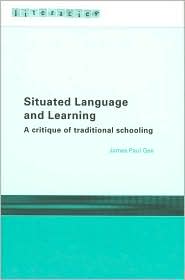 Games Paul Gee’s second incursion into game scholarship follows the footsteps of his previous work, What Video Games have to Teach us about Learning and Literacy (2003), in the sense that instead of looking at games exclusively it uses games to explain and improve on educational practices and theories. While in his previous work Gee talks about video games, learning, and literacy, in this work he talks about education in a more general context. This work’s subtitle is truly fit for what it does – critique traditional schooling by showing what games do better than schools in regards to teaching
Games Paul Gee’s second incursion into game scholarship follows the footsteps of his previous work, What Video Games have to Teach us about Learning and Literacy (2003), in the sense that instead of looking at games exclusively it uses games to explain and improve on educational practices and theories. While in his previous work Gee talks about video games, learning, and literacy, in this work he talks about education in a more general context. This work’s subtitle is truly fit for what it does – critique traditional schooling by showing what games do better than schools in regards to teaching
Gee opens his work with reflections on how school children do not learn to read, not in the sense of decoding, but in the sense of comprehension, specially with specialist varieties of language. He argues that the phenomenon called the fourth grade slump, a problem where children who seem to be able to read during their early ages cannot comprehend texts beyond the 4th grade level, is due to the lack of exposure to specialist language during their early development. Gee argues that using games like Pokemon and Yu-Gi-Oh train children on how to learn specialist varieties of language, as these games themselves contain a lot of technical words. The majority of the book, then, continues to do the same – point out the educational system’s shortcomings and show how games put into practice some of the best contemporary theories of learning.
There are, however, two points which stand out among the rest. Gee’s arguments on situated learning and on affinity spaces seem to be the most outstanding section of this book.
Traditional schooling, gee argues, consists more about dry lectures and memorization of facts than it does about actual practice and experience, and according to Gee, and many contemporary learning theories, it is in practice and experience where learning actually takes place. Gee argues that, for example, in physics lessons, students should not be listening to extended lectures on the topic, but practicing and experiencing physics by engaging on experiments. This learning through experience is what Gee calls situated learning. Gee then proceeds to explain how Rise of the Nations provides for situated learning of the game. He calls tutorials ‘supervised sandboxes’ which allow the player to try out the game and how to play it. This is something that classrooms do not do. In the sections that talk about situated learning, Gee is truly at his best.
Gee’s other outstanding section deals with affinity spaces. In order to get his point across to the reader, Gee compares the notion of affinity spaces to a similar concept often applied in educational settings: the community of practice. Both in an affinity space and a community of practice a group of people get together to engage with a certain activity. The difference between the two ideas, according to Gee, is that the connotation of a community of practice implies a sense of belonging – if someone des not belong to a specific community (for example 8th grade science students from St. George’s Middle School) they will not be allowed to engage with the activity. In affinity spaces, on the other hand, The other problem Gee has with communities of practice is the notion of practice – an activity engaged with in order to improve, but never put into actual, situated use. Affinity spaces, however, allow for both practice and situated use.
Overall, the book is well written, and the language used is mostly appropriate. Reading Gee try to avoid academic language by using terms like “Lots of times” instead of “a lot of times” tends to become annoying after the first few pages, but the coherence of argument and the eloquence with which he puts forth his ideas more than make up for Gee’s assumptions of colloquial language use. Still, the greatest flaw of this book is possibly found not in the book itself but in the expectations of the reader. After reading Gee’s previous work dealing with games (2003) which focused first on games and second on literacy (and even then literacy was linked strongly to games), a reader expecting a book on game-based education (as I was) might be disappointed, as the book focuses on education and how educators and policy makers could learn from educational principles implemented in games.
Although Gee’s book does talk about games, they are treated as models of educational learning and not as games. The focus on the book is not games, but education, which makes the book an excellent addition to any educator’s library. The book’s ideas might influence teachers to change the way they handle their classes for the better. However, someone who is interested purely in games – rules of play, narrative, history, or effects on society – will be disappointed.
No comments:
Post a Comment